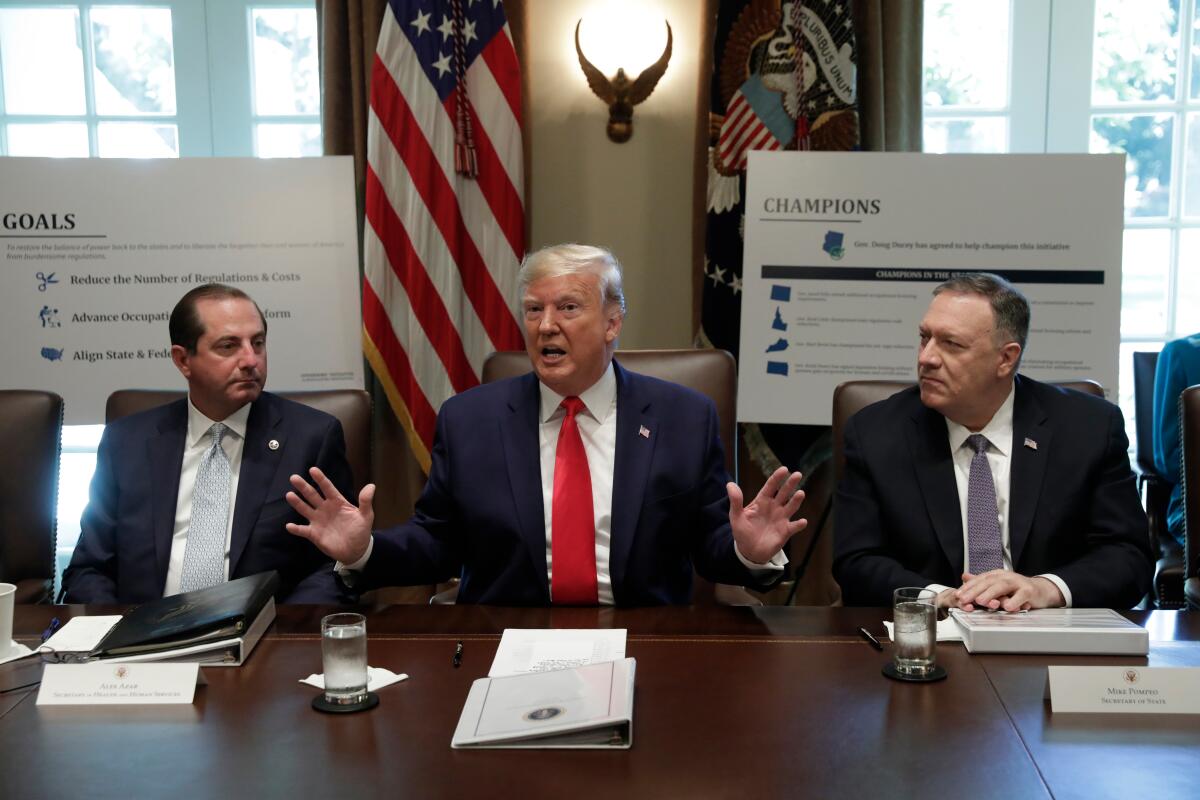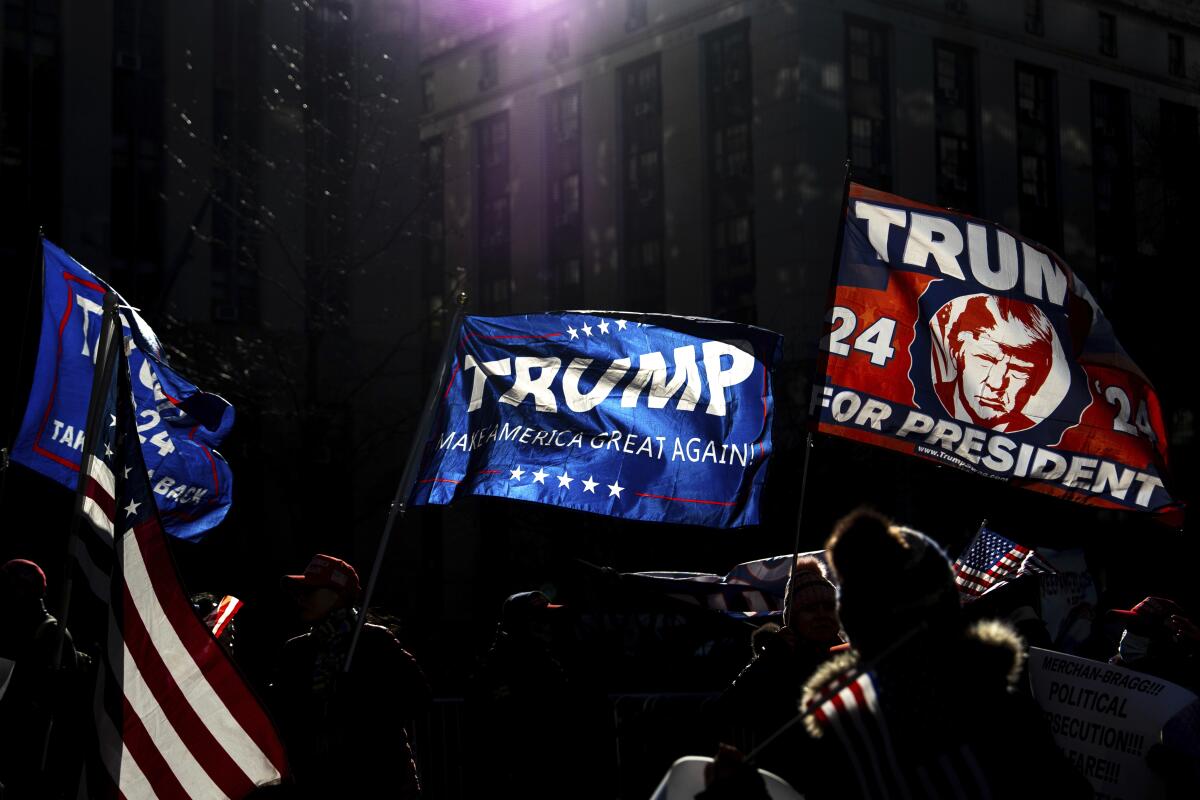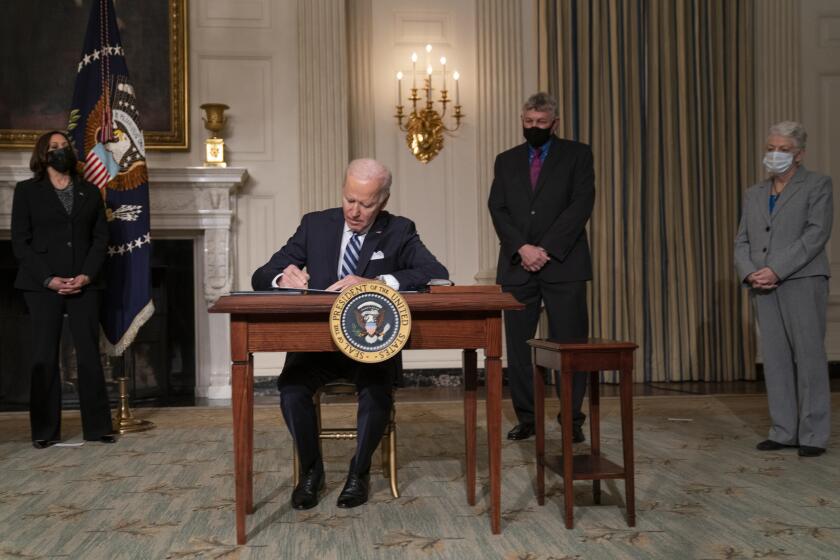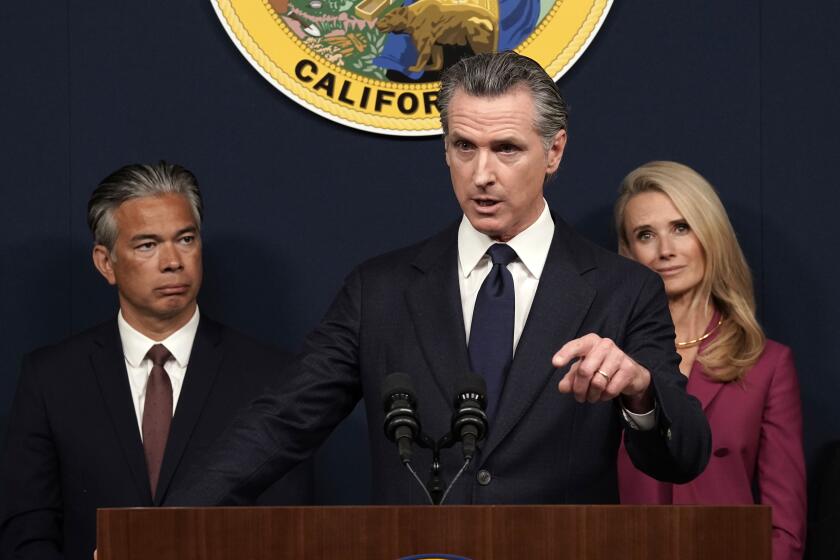Trump made many ‘Day 1’ promises. Will he make good on them?

- Share via
- President-elect Trump has promised to take immediate action on immigration, the economy and other matters, including through executive orders.
- California Atty. Gen. Rob Bonta and others say they will challenge any new measures that violate the Constitution or existing law.
From the start of his campaign to retake the White House, President-elect Donald Trump promised to go big on his first day back in power.
In a series of early videos outlining his plans and in stump speeches across the country, Trump said he would use executive orders on “Day 1” to bypass the normal legislative process and secure major changes to U.S. policy with the simple stroke of his pen.
He promised to unilaterally upend the long-recognized constitutional guarantee of birthright citizenship by signing an executive order informing federal agencies that, “under the correct interpretation of the law,” children of undocumented immigrants do not automatically receive citizenship by being born on U.S. soil.
He said he would “reverse the disastrous effects of Biden’s inflation and rebuild the greatest economy in the history of the world,” place new restrictions on gender-affirming care for transgender youth, halt the transition to electric vehicles in favor of fossil fuels, and use a decades-old public health statute known as Title 42 and the U.S. military to initiate “the largest domestic deportation effort in American history.”
“We will secure our borders and we will restore our sovereignty starting on Day 1,” Trump said. “Our country will be great again.”
Former President Trump has staked out an array of policy positions for a second term, many of them lofty, vague, or legally dubious ideas.
Trump’s promises have long excited Republicans and set Democrats on edge, but the anticipation has built ahead of his inauguration Monday, especially as media outlets have reported more than 100 executive orders are in the works and conservative members of Congress have said the president-elect intends to move quickly and aggressively — with their encouragement.

“There is going to be shock and awe with executive orders,” Sen. John Barrasso, a Wyoming Republican and the Senate majority whip, said on CBS’ “Face the Nation.” “A blizzard of executive orders on the economy, as well as on the border.”
Rep. August Pfluger, a Texas Republican, told Fox News Digital that a House caucus he leads — the Republican Study Committee — recently received a briefing on what to expect from Trump’s deputy chief of policy, Stephen Miller. The group “is in lockstep with the incoming Trump administration” and “committed to working around the clock to deliver on the promises we made to the American people, especially when it comes to securing our border and enforcing immigration policies,” Pfluger said.
What Trump’s plans will mean for the nation — and on what timeline — is not clear. Executive orders indicate a president’s intention to take swift action without waiting on Congress, but initiating their underlying policies often takes time, experts said — requiring a president’s Cabinet appointments to win confirmation and his administration to settle in first.
“There’s a lot that’s possible, but not on ‘Day 1,’” said Bert Rockman, a professor emeritus of political science at Purdue University and an expert on executive and presidential powers. “The expectation that a lot of things are going to be done right off the bat, above and beyond [Trump’s] mouth, is probably precipitous.”
There is also the matter of legal challenges. During Trump’s first term, his efforts to enact policy through executive orders were repeatedly stymied by litigation brought by California and other liberal states — and those states are already gearing up to challenge Trump’s agenda once more, said California Atty. Gen. Rob Bonta.
“We’ve been talking, preparing, planning. We have [legal] briefs on the shelf where we just need to dot the I’s, cross the Ts, press print and file,” Bonta said in an interview with The Times. “We’ve listened to what Mr. Trump has been saying, his inner circle has been projecting, what Project 2025 says in black and white in print, and preparing for all the possibilities.”
Immigrant rights and other advocacy groups have also been preparing for a fight, including in consultation with Bonta’s office and at “Know Your Rights” events throughout the Los Angeles region, said Angélica Salas, executive director of the Coalition for Humane Immigrant Rights, or CHIRLA.
“We had a meeting directly with [Bonta] to really talk about the things that we need to do to prepare and to ensure that we defend access to education, access to healthcare — that our schools, our clinics, our courtrooms, our shelters are all safe from [immigration] enforcement, and that we are ready to participate, as we did in the first Trump administration, as plaintiffs if necessary or as ourselves litigating directly against [these] kind of attacks,” Salas said.
Bonta said firestorms that have decimated some areas of L.A. County in recent days are a major part of his focus now and creating new demands on his staff, but that they will not undercut his team’s readiness to defend Californians’ interests against illegal Trump orders.
“We’re ready, we’re prepared,” Bonta said. “We expect the actions to flow on Day 1, immediately — and we’re ready for what comes.”
President Biden arrived at the White House ready to wield his pen to dismantle Donald Trump’s legacy and begin pushing his own priorities.
Trump’s transition team did not respond to requests for comment. However, experts said that Trump and his team are more prepared than they were at the start of his first term. Trump’s process for nominating Cabinet and other administration leaders is well ahead of where it was at his first inauguration, and that will result in a more efficient and successful start to his second term, they said.
In addition, conservative thought leaders — including those behind the Project 2025 playbook — have been contemplating Trump’s return for years, and have no doubt been helping him craft orders that are less vulnerable to legal challenges, the experts said.
“He certainly will have a more experienced administrative team — including himself. He’s been president,” said Mitchel Sollenberger, a political science professor at University of Michigan-Dearborn and author of several books on executive powers.
Still, Sollenberger said, “the realities of government are completely different than snapping one’s fingers.”
Executive orders may be unilateral dictates, but they still must follow a prescribed legal process.
Trump may be able to quickly undo executive orders put in place by President Biden — who himself issued a slate of executive orders in the first days of his administration, some to undo past Trump policies — and could issue orders that are more “symbolic” than prescriptive.

Trump also could pardon or commute the sentences of his many supporters who were criminally charged and convicted for their role in the riot and insurrection at the U.S. Capitol on Jan. 6, 2021 — which he repeatedly promised to do on the campaign trail.
However, Trump cannot issue orders that contradict the Constitution or existing laws set forth by Congress. And if he tries to do so, the experts said, he will be challenged in court by advocacy groups and a coalition of liberal states — opening the door for judges to halt his orders from taking effect while the legal battles play out.
California had success in challenging Trump policies during his first term, filing more than 100 lawsuits against the federal government and winning many. And lawmakers and other leaders in the state have already signaled they are ready to do so again, with Gov. Gavin Newsom convening a special legislative session to secure funds for the expected legal fights ahead.
Newsom’s preemptive strike signals the return of the hostile relationship between Democratic-controlled California and the Trump administration.
The L.A.-area fires have shifted priorities somewhat, and the special session that began last month will now be used in part to address fire needs. But Newsom and other officials have remained adamant that, when called for, they will take the Trump administration to court.
“We will work with the incoming administration, and we want President Trump to succeed in serving all Americans. But when there is overreach, when lives are threatened, when rights and freedoms are targeted, we will take action,” Newsom said recently.
Rockman and Sollenberger said they expect Trump to issue many executive orders. But because such orders are such a heavy and legally fraught lift, they also expect his administration to prioritize — and come out swinging — on a select handful of orders that they deem most important to Trump’s base.
Orders with “some mass resonance, especially to his base, are the ones that I would expect him to give some priority,” Rockman said. “He’ll try to do the ones that are the most prominent.”
That’s likely to include orders on immigration that speak to border security and Trump’s promise to begin deportations, Rockman said. It may also include efforts to shore up loyalty among the vast federal bureaucracy, including by pushing “Schedule F” — a plan to replace thousands of career civil servants with Trump loyalists, Rockman said.
Bonta said he also expects Trump to want to “come out with a splash” and to move most quickly, and brashly, on some of his biggest promises, especially around immigration. That includes his promises to end birthright citizenship and begin mass deportations, potentially using the military.
Those are also the sort of measures “that he can’t do” legally, and that California would challenge, Bonta said.
“We know exactly what court we’re going to sue him in and what our arguments are and who’s suing and who we’re suing with and how we create standing,” Bonta said.
The state is also readying responses to Trump challenges to clean-vehicle and other environmental regulations; a proposed ban on mail delivery of abortion pills; a unilateral closing of the U.S. Department of Education; the easing of Biden-era regulations on homemade “ghost guns” and other firearms; unlawful orders involving matters such as diversity, equity and inclusion programs or LGBTQ+ rights; the conditioning of emergency wildfire aid for the L.A. area on unrelated conservative demands being met; and more, Bonta said.
President-elect Donald Trump casts himself as a strongman fixer of major problems, but has begun to walk back certain campaign promises.
Already, Bonta’s office has intervened in court to defend a federal rule expanding healthcare access under the Affordable Care Act to Deferred Action for Childhood Arrivals, or DACA, recipients, and separately to defend Clean Air Act regulations on vehicle emissions, in anticipation of the Trump administration deciding to not defend the rules itself.
Bonta acknowledged that Trump’s team may have learned from early mistakes during his first term, when the administration lost policy fights because it tried to sidestep legal protocols for executive orders. But Bonta said he is also banking on the fact that Trump’s “desire to be aggressive” will once again cause him to “stumble.”
“He has not demonstrated discipline; he has not demonstrated compliance with the law; he has not demonstrated the willingness to stay within his actual grant of authority as the president of the United States. He reached outside of it many times under Trump 1.0. He used funding that he shouldn’t have used for a purpose it was not allowed for; he didn’t follow the required procedures and processes under federal law. He did it time and time again, and we stopped him time and time again in court,” Bonta said. “I expect that again.”
Bonta said that the recent fires in L.A. County have created new demands on his office, but that it remains in “good shape” to handle those demands and any Trump administration orders it deems unlawful simultaneously — in part thanks to millions of dollars in additional funding that he anticipates will be provided by the state Legislature.
“They’re up for the challenge. They want to do it. They’re mission-driven,” Bonta said of his team. “We are definitely busy, but not overly strained and certainly not over capacity.”
Bonta also stressed that fighting Trump’s agenda was not about “political gamesmanship” but “real outcomes for real Californians” that will also save the state money in the long run.
For example, California successfully fought a plan under Trump’s first administration to add a citizenship question to the U.S. census, which state officials believed would have stoked fear and produced “an undercount that would have cost us billions of dollars,” given that federal funding for states is tied to population, Bonta said. It also fought off costly changes to environmental regulations and a proposed ban on federal public safety grants going to California’s sanctuary cities, he said.
Defending against unlawful immigration measures and attacks on green energy policies this time around will have a similar effect, Bonta said — protecting the California workers and industries that have made the state the fifth-largest economy in the world.
Salas, of CHIRLA, said she lives in the greater Pasadena area and has family and friends in the immigrant community who lost their homes in Altadena. The fires came right after Border Patrol agents launched one of the largest immigration enforcement sweeps in the Central Valley in years in Bakersfield, she noted — compounding fear and “panic” in the community.
And yet, the response has been one of compassion, generosity and resilience, she said — all of which will come in handy in the days to come.
“I see immigrants across my city helping neighbors, standing with each other, cleaning up debris, opening their doors to neighbors that lost their homes,” Salas said. “That’s the immigrant community that I know, and that’s the immigrant community that is willing to stand up for each other — and against this president.”
More to Read
Get the L.A. Times Politics newsletter
Deeply reported insights into legislation, politics and policy from Sacramento, Washington and beyond. In your inbox three times per week.
You may occasionally receive promotional content from the Los Angeles Times.















